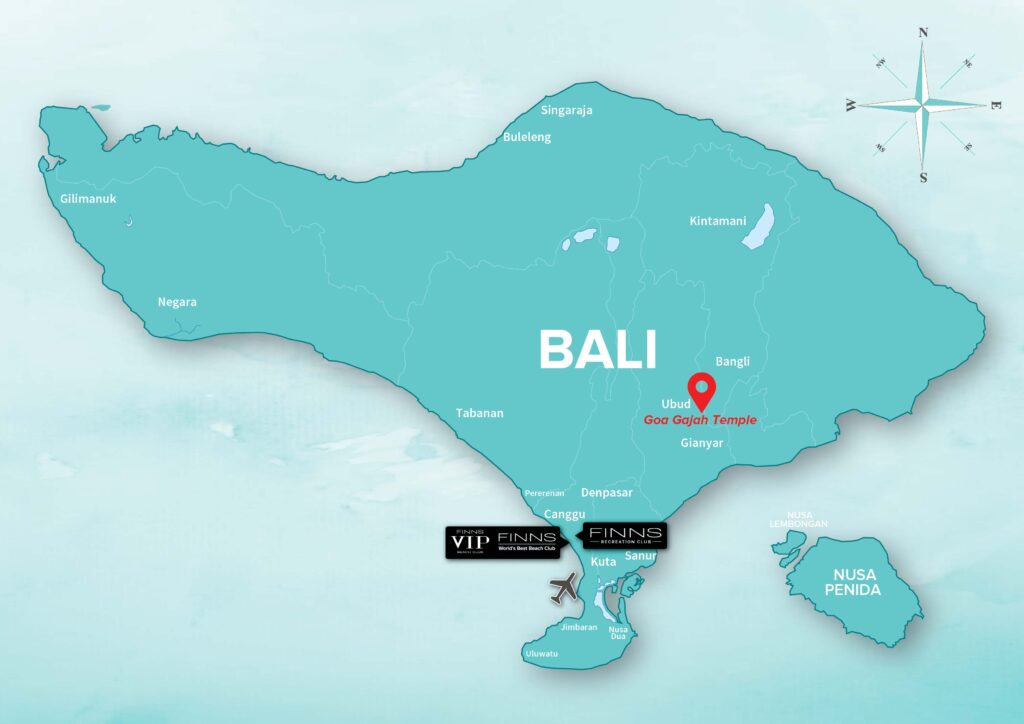Goa Gajah Temple, or the Elephant Cave Temple, is one of the most sacred and interesting places in Bali.
It’s a living temple where people continue to worship to this day, and you can find it on a visit to the heartland of Bali near Ubud.
Our guide to Goa Gajah will tell you what you can expect to find at this spiritually enlightening place.
Where Is Goa Gajah Temple? Jalan Raya Goa Gajah

The temple complex is on the border of the Bedulu Village, which is just 6 kilometres outside of Ubud.
The full Goa Gajah Address is Jalan Raya Goa Gajah, Bedulu, Blahbatuh, Gianyar Regency, Bali, Indonesia
How To Get To The Elephant Cave Temple?

If you’re in Central Ubud, then the easiest way to get here is going to be to use Grab or Go-jek, the ride-sharing app. That will be cheap and safe and ensure that you’re not ripped off.
If you want to visit the Goa Gajah Elephant Cave from further afield, then you might consider if you want to stay in Ubud. Ubud is an awesome destination with a ton of things that people want to see.
You can enjoy the Campuhan Ridge Walk, the Sacred Monkey Sanctuary, the Tegallalang Rice Terraces, and so much more.
If you opt to stay in Ubud, you could either join an organized tour of Ubud, which will make it very easy for you to see everything nearby Ubud without having to make your own arrangements, or you could hire a private car driver to get out to Ubud.
We think a tour of Ubud is the better option as there’s more to see in the Ubud area than you can easily fit into a single day. You can arrange a tour through the Bali Res Centre (contact details are in the FAQ section later in this article).
Finally, you always have the option to rent a scooter, but that’s something we discourage. It’s hard to get to Ubud on a scooter as the road is not great, and traffic tends to make its own rules.
Driving a scooter in Ubud is likely to lead to an accident, and even experienced motorcyclists struggle to stay safe on the roads here.
It’s also something of a challenge to be road-legal, and if you’re not road-legal, you won’t be properly insured on a scooter in the event of an accident.
When Is the Goa Gajah Open?

As with all temples in Bali, if you’re a Hindu worshipper, the temple is open for 24 hours a day.
However, non-Hindu visitors would prefer you visit the elephant cave between 8 a.m. and 5 p.m. each day.
You may be able to enter Goa Gajah after these hours or before them, but you may also be asked to leave.
How Much Does It Cost To Get Into Goa Gajah?

The entrance fee to the Goa Gajah elephant cave is 50,000 IDR per person as we go to press.
That’s a very reasonable and affordable fee and serves as a donation to this Hindu/Buddhist temple.
This fee includes the parking entrance fee too.
The History Of The Elephant Cave And Goa Gajah

We don’t know how old Goa Gajah is, and it’s not entirely certain why a cave was built on this site in the first place.
Local legends say that it was created by the impression of a fingernail of the legendary giant Kebo Iwa, though it seems more likely that it was hollowed out of the rock as a place for spiritual meditation.
What Does The Name Goa Gajah Mean?

One odd thing is that though the name “Goa Gajah” means “Elephant Cave”, there are no elephants present here, and some say that the name comes from Lwa Gajah, which was the name of the Petanu River prior to the current era.
Others say that the name is clearly drawn from images of the Hindu God Ganesh (Ganesh or Ganesha is always portrayed in the form of an elephant).
However, if we put the name aside for a moment, it appears likely from the Buddhist imagery and Hindu imagery both of which have been well preserved by the Hindu priests who cared for this site – that it was built sometime in the 11th century as part of the “Bali Kingdom”.
The Kingdomship of Bali did not rule the whole island, however, and instead ruled some parts of the area, including Ubud.

The reason that we don’t know precisely how old this place is is that it was lost to time for a period and was rediscovered by the archaeologists of the Dutch colonizers during the year 1923.
Interestingly, the Dutch archaeologists didn’t find everything the site has to offer, the fountains and the bathing pool were only rediscovered in 1954!
What To Expect At Goa Gajah

This temple is best known for its menacing giant face and smaller faces that have been carved into the stone.
The carved images are said to ward off evil spirits and to keep the area safe from harm.
Some surmise that the primary figure here must have been an elephant (thus offering another theory for why this is known as the “elephant cave”), but there’s no evidence of this.
One thing we do know for sure is that the cave was mentioned in the Javanese poem Desawarnana, written back in 1365!
If you want to enter the cave complex, you will need to walk down a very long flight of stairs, and while this is in relatively good condition, there is no alternative access for wheelchair users.
It’s not very big inside, however, and you may find it strewn with Hindu incense baskets, and the place often fills with the smoke of incense burning.
Goa Gajah’s also the home to 6 statues (there used to be 7, but one was destroyed by an earthquake) of women, each holding a water pitcher.
They are meant to symbolize the seven holy rivers of India – the Ganges, Sarasvati, Yamuna, Sindhu, Godavari, Kaveri and Namada.
About Goa Gajah And UNESCO’s World Heritage List

This temple near Ubud is clearly one of the great cultural heritage sites in Bali, and in 1995, it was added to UNESCO’s World Heritage Tentative List.
This list does not confer special status upon a site but instead acts as a waiting list for official confirmation of “World Heritage” status.
Many developing nations eagerly pursue this status as it can mean 100,000 extra tourists to any site lucky enough to be confirmed by UNESCO.
However, in 2015, the Balinese government, on behalf of the Balinese people, withdrew 15 sites from the tentative list, including the elephant cave.
The reason for this was simple. It was strongly felt that a Hindu or Buddhist temple that is used for worship should primarily serve the Balinese locals that use it, and it should not be designated as a global tourist attraction.
That doesn’t mean that visitors are not welcome at these sites, but it does mean that the authorities in Bali are taking steps to limit the number of visitors to sacred sites.
This should ensure that these places are preserved for continued use by future generations of Balinese and remain less crowded and thus nicer for everyone who visits them.
Tips For Your Visit To The Elephant Cave

If you want to ensure your temple visit is everything you want it to be, it can help to:
-
Not swear – profane language upsets worshippers
-
Not use flash in the temple area – it’s fine to use flash outside, but inside, it’s going to distract worship
-
Not to interfere with worship – the same as you wouldn’t want someone to interfere with prayers in a church
-
Not to photograph someone in an act of worship – this can really upset believers
-
Dress appropriately – we’ve got a dress code outlined in the FAQ below
-
Attend the Anggara Kasih Prangbakat – this is the Piodalan anniversary for the temple (it takes place on different dates as the temple uses the Balinese 210-day Pawukon calendar rather than the Gregorian Calendar). It’s a major festival and really changes the atmosphere here.
FAQs
How Much Is The Entrance Fee To Goa Gajah Temple?
As we said above, it costs 50,000 IDR per person to get into the elephant temple at Goa Gajah. This includes the use of the parking area if you need to use it.
What Is The Significance Of Goa Gajah Temple?
It is a deeply holy place to the local people and offers interesting insights into the culture and history of the island.
You can find ancient inscriptions and many a stone figure inside the cave’s walls.
It’s also a popular and extensive bathing place, and the nearby river junction is said to come from a holy spring, and the water is considered to be holy water.
How Old Is Goa Gajah Temple?
We don’t know, exactly, as the temple was lost to the Balinese for a long period of time, during which its history faded from memory.
However, evidence on the site suggests it dates back to at least, the 11th century.
What Is The Dress Code For Goa Gajah Temple? What Is The Dress Code For The Elephant Cave Temple?
There is a dress code for all temples in Bali, and this includes Goa Gajah. You must dress respectfully, which means your shoulders should be covered, and your legs should be covered.
You can rent or buy a shawl and a sarong at the elephant cave or from one of the vendors nearby. You will not be allowed inside the elephant cave if you are not appropriately dressed and will be asked to leave if you don’t adhere to the dress code inside Goa Gajah.
We should also note that as with all sacred Hindu sites in Bali, women who are menstruating are forbidden to enter the elephant cave as they are deemed “unclean” in scripture and would profane the holy site.
How Do You Book A Trip To Goa Gajah Temple?
We recommend that you book your trip to Ubud and Goa Gajah through the wonderful folks at Bali Res Centre.
This is a fully locally owned and operated travel service that can ensure you get to Ubud past the traffic on the way in the best fashion and that you have a great time when you arrive.
Their prices are very competitive thanks to their local contacts, and you can ensure that your time in Ubud helps the local economy of Bali rather than subsidizing a multinational corporation exploiting the island. It’s a win-win.
Final Thoughts On Goa Gajah Temple Complex
We’d strongly recommend that everyone who can visit Goa Gajah during their Bali holiday does so.
The elephant cave is such an unusual and fascinating place, and it gives a wonderful insight into local heritage and culture.
It’s also very easy to combine a visit to this spiritual place with other interesting and exciting attractions in the heartlands of Bali.











